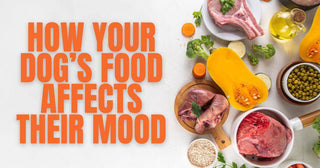I used to think food was just food. As long as my dog, Bella, was eating and staying at a healthy weight, I figured I was doing everything right. But over time, I started noticing little changes that didn’t make sense.
Bella had always been a happy, easygoing dog. But a few months ago, she became irritable. She would growl when someone touched her toys. She seemed restless and would pace around the house at night. Sometimes she’d bark at nothing in particular, like she was on edge.

At first, I thought maybe she wasn’t getting enough exercise or was picking up on my stress. But then I wondered if her diet could have something to do with it. I had never connected what she ate to how she felt emotionally.
Turns out, food can do more than just fill your dog’s belly—it can affect their mood and behavior in ways I didn’t expect.
How Food Impacts Your Dog’s Brain and Body
Just like people, dogs need the right nutrients to feel their best. Certain ingredients help balance hormones and support a healthy brain. Others can cause inflammation or spikes and crashes in blood sugar, which can lead to anxiety or irritability.
I learned that diets high in fillers, artificial additives, and low-quality proteins can sometimes make dogs feel sluggish or edgy. On the other hand, whole, nutrient-rich foods can help them stay calm and focused.
For example:
-
Omega-3 fatty acids (like those in fish) help reduce inflammation and support brain health.
-
Complex carbohydrates provide steady energy instead of sudden bursts.
-
High-quality proteins help keep muscles strong and mood stable.
When I read about this, I realized Bella’s old food was full of corn and meat by-products, with very little real meat or healthy fats. That’s when I started thinking about switching to higher-quality and even organic pet food.
The Changes I Made
I decided to switch Bella to a higher-quality diet. I didn’t go fully organic right away, but I chose a brand that used real meat, whole grains, and no artificial preservatives. I also added a little fish oil to her meals after asking my vet.
Just like when you switch any dog food, I did it gradually. I started with 25% new food mixed in and increased it over two weeks.
What I Noticed
It didn’t happen overnight, but within a month, Bella seemed more like her old self. Here’s what I saw:
- Calmer Behavior
She stopped pacing at night and didn’t bark as much at random noises. It felt like her mind was clearer.
- Better Focus
During training or playtime, she paid attention longer. She wasn’t as easily distracted.
- More Even Energy
Instead of sudden bursts followed by long naps, she seemed to have steady energy throughout the day.
- Happier Mood
She started wagging her tail more again and seemed excited about the little things—like going for walks or greeting visitors.
Tips for Other Dog Owners
If you’ve noticed mood changes or signs of anxiety in your dog, here are a few things I’d recommend:

1. Check the Ingredients
Look at what’s actually in your dog’s food. If you see lots of fillers or artificial additives, that could be part of the problem.
2. Talk to Your Vet
Before making big changes, ask your vet for guidance. They can help you pick the right food and rule out other health issues.
3. Transition Slowly
Switching too quickly can upset your dog’s stomach. Mix in the new food a little at a time.
4. Watch and Take Notes
Keep track of any changes you see—good or bad. This helps you understand how your dog responds.
5. Consider Supplements
Things like fish oil or probiotics (with your vet’s okay) can also support your dog’s mood and digestion.
Final Thoughts

I used to think that a dog’s mood was just about their environment—how much exercise they got, whether they felt loved. But now, I see that what goes into their bowl matters just as much.
Feeding Bella better food didn’t just improve her health—it helped her feel happier and more balanced. It reminded me that our dogs can’t choose what they eat. They trust us to make good decisions for them.
If your dog has been acting differently, it might be worth looking at their diet. I’m glad I did. Bella may not understand what “nutrients” or “omega-3s” are, but she feels the difference. And that’s what matters most.
